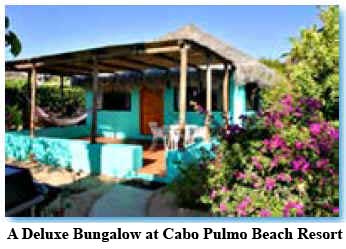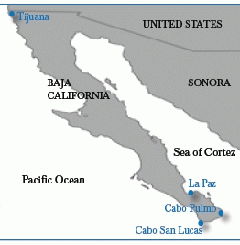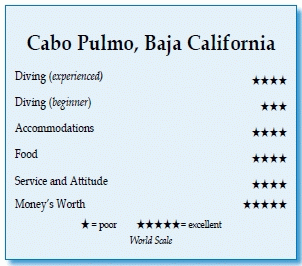Cabo Pulmo, Baja California, MexicoContents of this Issue: Cabo Pulmo, Baja California, Mexico Chikungunya-Carrying Mosquitoes in the Caribbean Travel Reviews Coming Up in Undercurrent What SSI’s Sale Means to Divers Buddy Dive Shut Down in the Galapagos The Strange Case of a Missing Diver in the Caymans The Shark-Riding Trend - - or Dumb Divers Looking Dumber Lionfish: The Caribbean Endgame One Small Idea for Lionfish Eradication Editorial Office: Ben Davison Publisher and Editor Undercurrent 3020 Bridgeway, Suite 102 Sausalito, CA 94965 a fish-filled marine preserve for divers who like “rustic” from the February, 2014 issue of Undercurrent
Dear Fellow Diver: A southern wind was blowing steadily through Cabo Pulmo in late October, wreaking havoc on my dives. Of course, the wind, according to many locals, was "stronger than I've seen in a long time," and "it's not usually like this." On my first dive day, it was merely "breezy" when I backrolled over the side at El Bajo, a small reef north of Cabo Pulmo. I went down to 60 feet and had 80-foot visibility, so I forgot about the wind above. There were healthy hard and soft corals standing tall, and some of the usual Baja suspects -- Panamic porkfish, graybar grunts, Cortez rainbow wrasse, guineafowl puffers -- eyed me casually as they made their rounds. The highlight was at the end of the dive, one Cabo Pulmo is famous for. Big-eye jacks, thousands of them, whirled around in a massive school, with a steady line of more jacks moving in and out. Their silvery scales shimmered as they clustered together, 15 feet across and six feet high, hovering just above the sea floor.
Indeed. Cabo Pulmo is just 60 miles east of Cabo San Lucas, but the East Cape is a world away from the bustle of resorts and cruise ships on the Pacific side. My hour-long drive up Highway 1 from the airport and the supermarket (it's wise to stock up in San Jose del Cabo, as groceries are few and costly in Cabo Pulmo) took me to a six-mile stretch of gravel road that hugged the hilly, cactus-covered coast of the Sea of Cortez. I passed a cow here, a farmer there, some isolated concrete houses and thatched-roof casitas. After 30 minutes, I reached Cabo Pulmo, composed of a few homes, three dive shops and six restaurants, all on a dirt road leading to the beach where dive boats are loaded onto pickup trucks and backed into the sea for launch. Everything runs on solar powers and generators, and the town just got its first cell tower. If you like vacationing in "the middle of nowhere," this is it, but it is a beautiful nowhere.
Based on a previous trip to Baja, I knew October and November were the best months for visibility and water temperatures. I booked lodging at Cabo Pulmo Beach Resort, the largest lodging in the area and featured in the last article Undercurrent did on Cabo Pulmo (in March 2008). In retrospect, I wish I had done more research on the area's private houses and smaller lodgings, but it was too late -- I had already sent the 50-percent deposit required upfront, and I was booking during high season. The resort consists of 30 rooms and cottages of various sizes, laid out on sand-packed streets. My bungalow was in the middle of one street, and it felt like suburbia. Many bungalows had frequent return guests or were owned by part- or full-time U.S. expats. The only place available for my stay was a Deluxe Bungalow, a spacious room with a vaulted thatched roof and a queen bed draped with mosquito netting. The full kitchen in the corner had everything but a wine opener. The tiled bathroom had a large shower and plenty of hot water. The L-shaped sofa was comfortable for afternoon reading and naps, but a good backup was a hammock on the tiled front patio, surrounded by shrubbed walls for privacy from the bungalows on either side. The resort says its tap water comes from a well and is safe to drink, but I had already bought bottled water at the supermarket, so I stuck with that. I'm a single woman, but I have no qualms about going solo to Baja California. My first trip, to Loreto (read my travel report in the February 2013 issue), went without a hitch. Same in Cabo Pulmo -- no threats or harassment, everyone was nice and I felt totally safe. Because tourism is Baja California's top source of income, they'll do everything they can to keep it stable, from widening the highways to including English on all menus. And based on the number of sunburned English speakers, and the number of "For Sale" home listings piquing their interest, I am not alone in enjoying this area. Online reviews were lukewarm on Cabo Pulmo Beach Resort's dive shop, but glowing about Cabo Pulmo Watersports and its owner Ricardo Castro.(Cabo Pulmo Divers, just down the road, is owned by another batch of Castros -- they're all relatives of the original family who settled Cabo Pulmo in 1900 -- and also gets good reviews.) I checked into the dive shop, a concrete block a few steps from the resort, at 8:30 a.m., but it still took a half-hour to get to the beach every day because new divers needing rental gear showed up daily. Charming Ricardo (Don Ricardo, the boat driver, is his father) shows a shiny white smile, but I never got to dive with him, because he either took out the other boat of divers or took the day off. Chris, the office manager, is a friendly, blonde, 50-ish American who answered e-mails quickly. Once the boat was in the water, Don Ricardo told us where to sit for balance, while Leonardo set up the gear. They both helped divers into their BCDs, then on a count of three, we all backrolled in and waited on the surface so Leonardo could ensure we were OK before descending. Aluminum 80s (no Nitrox) were filled to 3,000 psi, but our dives only averaged 45 minutes -- Leonardo said that was a marine park rule. I was skeptical, not having read that on any dive shop's website. However, when I looked online, I saw a 2011 report from underwater photographer and Undercurrent subscriber Mike Boom that there was a policy among the different dive operations that no boat can remain on a site longer than 45 minutes; however, one dive guide told him that it was a Mexican national park policy, while a manager told him it was an agreement among dive operations.
I chose Los Caballeros for dinner, because it had an overhead TV in its thatched-roof bar and dining room, and the World Series was playing, albeit on ESPN Desportes. Octavio, the gracious manager, served up two margaritas topped with Cointreau, and a large batch of chips, salsa and superb guacamole for $18 total. Everything from tacos to steak were on the menu, and the Mexican breakfasts were hearty. Los Caballeros became my haunt, but other restaurants that looked good were Nancy's, a lovely outdoor restaurant run by an 80-year-old American La Palapa, with inexpensive tacos and beer right on the beach, and Alicia's, which got raves for its chile rellenos. Alicia also offers two lovely casitas -- with private patio, hammock, tiled kitchen and walk-in shower -- priced at just $50 and $60 per day if you rent from her directly (Cabo Pulmo Watersports offers them as part of its diving/lodging packages but charges $75 and $100, respectively); however, Alicia only books them by phone and she only speaks Spanish. There were a few "For Sale" signs in town -- a beachfront compound with two separate houses was asking $1.2 million, or just the smaller house for $400,000. So much for inexpensive Mexico. I dove again with Vickie and Laurie the next day. Leonardo said that because of wind and currents, we were going to repeat yesterday's dives. Vickie and I looked at each other but stayed silent. Don Ricardo, however, saw our look and said something to Leonardo in Spanish that included the words "repeat" and "dives." So Leonardo changed course to head south to the small wall of El Cantil and El Islote, a pinnacle. At the latter, we dropped to 40 feet and circled the pinnacle twice. Dozens of butterflyfish, damsels and surgeonfish were feeding on the current side. I wasn't knocked out by marine life that day, and Leonardo must have read my mind. On the way back, he pointed to a curve of the bay where masses of sharks spawn in shallow water between February and May, so many that divers can't help but bump into them. "That's the best diving here," he said. The wind was blowing at 15 m.p.h. on my third day, but I went to the dive shop anyway. Then Don Ricardo walked in and announced the marine park was closed and no dive boats were going out. But when I ran into Nancy, the restaurant owner, later, she said, "The park is never closed. Maybe the marinas close the harbors, but the park does not." I noticed later that Cabo Pulmo Resort was sending out two boats (they had ladders). So I got bullshit from the dive shop a second time, although I was glad not to deal with that wind. I drove south 10 minutes on the gravel road to Los Frailes, a perfect halfmoon of a bay, and one of the most beautiful -- and isolated -- beaches I've seen in my extensive travels. On one end were some vacation homes and an abandoned hotel, on the other end was a string of umbrella-like palapa stands. In between was a fisherman's camp, parked right at the edge of the marine reserve's southern border. The beach was protected from wind so I snorkeled along the northern curve of the bay and saw dozens of hawkfish, two big clusters of bluechin parrotfish and two small eagle rays darting into the blue. Around that curve is a sea lion colony, and I dived there the next day. Bebo, a friendly fisherman, took the captain's chair. We circled around El Cantil twice again, and then at the mouth of Los Frailes, we approached 10 sea lions sleeping on the rocks. At 25 feet depth, the waves acted like a rocking chair, swinging us back and forth, as a couple of female sea lions came and swam around us for a while. Then we finned around the point, back to the area where I snorkeled, through schooling surgeon, butterfly and angelfish. Small juveniles nibbled at my legs, then darted away when I turned. The wind died down overnight, but it was followed by billowy gray clouds threatening to drop rain. I was heading over to the Pacific side that day, so I went to the dive shop to settle up my bill. On the way there, I met Leonardo walking back from the beach. "Do you want to see the bull sharks?" he asked. "Someone saw six of them at El Vencedor yesterday." I was ready to suit up but before I could form the word "yes," a raindrop landed on the sand, followed by a few more. "Never mind," Leonardo said. "Don Ricardo won't let us go if it rains." There may have been a threat of lightning -- I didn't ask at the time, but I later saw it and heard thunder on my drive back west. I like big marine life and I enjoy rustic vacations in the middle of nowhere, so I'll be coming back, most likely in the spring when whales and sharks are more commonly seen, and using my fractured Spanish to book a casita with Alicia. Otherwise, diving here is sufficient for a day or two, with the best opportunities for seeing some big schools of fish. However, if you prefer big ladders and assistance to get in and out of the boat, beware. And while Cabo Pulmo Watersports was very respectful of the marine life, this 45-minutedive limit, no matter who came up with it, means a minimal dive experience, especially for the price charged. Diving in Cabo Pulmo is rustic, like it was many years ago in the Sea of Cortez, when the author of the next story was there. -- J.V. P.S. While I said I didn't worry about my physical safety, I now know to put extra security around my debit and credit cards on future trips to Mexico. The only place I used my credit card was at the Hertz car rental and the Soriana supermarket near the airport. It ended up being used in an attempt to buy a laptop and electronics at the Best Buy in Laredo, TX. Luckily, my bank (USAA) was on it -- it said someone stole the info off my magnetic stripe. So let your bank know when you're traveling so it can be on the lookout for fraud.
|

I want to get all the stories! Tell me how I can become an Undercurrent Online Member and get online access to all the articles of Undercurrent as well as thousands of first hand reports on dive operations world-wide
| Home | Online Members Area | My Account |
Login
|
Join
|
| Travel Index |
Dive Resort & Liveaboard Reviews
|
Featured Reports
|
Recent
Issues
|
Back Issues
|
|
Dive Gear
Index
|
Health/Safety Index
|
Environment & Misc.
Index
|
Seasonal Planner
|
Blogs
|
Free Articles
|
Book Picks
|
News
|
|
Special Offers
|
RSS
|
FAQ
|
About Us
|
Contact Us
|
Links
|
3020 Bridgeway, Ste 102, Sausalito, Ca 94965
All rights reserved.

 But the awe wore off when I ascended into choppy
waves. I had to wriggle onto the simple fisherman's
panga, which had no ladder. It had three wooden platform
seats across, with tanks, weights and fins placed
randomly at the bottom.
Divers were
moved around the gear
when Don Roberto,
the captain, and
Leonardo, the divemaster,
needed to
get to it. Leonardo
always wanted my
group of six to surface
together. When
we did, he pulled
himself into the boat
first, then took our
weights and BCDs one at a time. Then each of us had to haul ourselves
in, scissor-kicking our way over the side
and making such an ungraceful landing that Don
Roberto sometimes couldn't help but chuckle. But
no one else was chuckling on that first dive.
Vickie, a friendly retiree from Vancouver, was
upset there was no ladder, because her husband,
Laurie, had a fused ankle, which made it hard
for him to climb in. "Believe me, you don't
want a ladder in these waves," Leonardo said.
Even though waves were only a relatively mellow
three- to four-foot height, Leonardo, a thirtysomething
Venezuelan who had come to Cabo Pulmo
to perfect his underwater photography, was also
their victim. The waves changed his angle of
entry so that he smashed his mask on the seat
when he came into the boat; safety-glass shards
went everywhere. As for me, I looked down to
see steady bleeding from just below my kneecap.
Seems I had caught the edge of a tank during my jump into the boat. David, a
government worker from the San Francisco Bay Area who was my dive buddy for
the day, handed me a rag to clean up the blood. "Some pretty rustic diving,"
he said.
But the awe wore off when I ascended into choppy
waves. I had to wriggle onto the simple fisherman's
panga, which had no ladder. It had three wooden platform
seats across, with tanks, weights and fins placed
randomly at the bottom.
Divers were
moved around the gear
when Don Roberto,
the captain, and
Leonardo, the divemaster,
needed to
get to it. Leonardo
always wanted my
group of six to surface
together. When
we did, he pulled
himself into the boat
first, then took our
weights and BCDs one at a time. Then each of us had to haul ourselves
in, scissor-kicking our way over the side
and making such an ungraceful landing that Don
Roberto sometimes couldn't help but chuckle. But
no one else was chuckling on that first dive.
Vickie, a friendly retiree from Vancouver, was
upset there was no ladder, because her husband,
Laurie, had a fused ankle, which made it hard
for him to climb in. "Believe me, you don't
want a ladder in these waves," Leonardo said.
Even though waves were only a relatively mellow
three- to four-foot height, Leonardo, a thirtysomething
Venezuelan who had come to Cabo Pulmo
to perfect his underwater photography, was also
their victim. The waves changed his angle of
entry so that he smashed his mask on the seat
when he came into the boat; safety-glass shards
went everywhere. As for me, I looked down to
see steady bleeding from just below my kneecap.
Seems I had caught the edge of a tank during my jump into the boat. David, a
government worker from the San Francisco Bay Area who was my dive buddy for
the day, handed me a rag to clean up the blood. "Some pretty rustic diving,"
he said. Cabo Pulmo National Marine Park is the gem. Fishing has taken its toll in
the Sea of Cortez, but locals established the park in 1995, banning all fishing
inside its borders, and marine life has bounced back. A 2011 study by the
Scripps Institution of Oceanography found Cabo Pulmo's biomass (total weight
of living species) increased by 463 percent from 1999 to 2009. One of the
researchers was quoted saying, "No other marine reserve in the world has shown
such a fish recovery." Throngs of sharks, stingrays and huge groupers have
been photographed repeatedly here. That was all threatened by the proposal of
a mega-resort to be built just outside Cabo Pulmo, but Felipe Calderon wisely
nixed the development in 2012 as one of his last actions as president of
Mexico. A local told me Calderon has been to Cabo Pulmo a couple of times, ,
bodyguards in tow, because he loves the place. I can see why.
Cabo Pulmo National Marine Park is the gem. Fishing has taken its toll in
the Sea of Cortez, but locals established the park in 1995, banning all fishing
inside its borders, and marine life has bounced back. A 2011 study by the
Scripps Institution of Oceanography found Cabo Pulmo's biomass (total weight
of living species) increased by 463 percent from 1999 to 2009. One of the
researchers was quoted saying, "No other marine reserve in the world has shown
such a fish recovery." Throngs of sharks, stingrays and huge groupers have
been photographed repeatedly here. That was all threatened by the proposal of
a mega-resort to be built just outside Cabo Pulmo, but Felipe Calderon wisely
nixed the development in 2012 as one of his last actions as president of
Mexico. A local told me Calderon has been to Cabo Pulmo a couple of times, ,
bodyguards in tow, because he loves the place. I can see why. For surface intervals, we returned
to the beach for tank exchanges.
After the choppy ride at El Bajo, we
went back to the same area to dive El
Vencedor. The hull of an ancient tuna
boat is still there, with pieces scattered
around the sand at 40 feet.
Visibility had gone down to 45 feet,
but two giant schools of burrito grunts
welcomed us as we ascended. Huge groupers
and bumphead parrotfish cruised
through the schools. Two moray eels
swam by, and a Cortez stingray buried
in the sand flapped off so quickly
that I jumped. Lots of rainbow wrasse
and Panamic soldierfish hovered around
the small reef, and Laurie found what
looked to be an enormous leopard grouper
lurking under the hull, glowing
orange in his dive light. When I surfaced,
the waves had risen to about six feet. The water was 82 degrees, so I
only wore a shortie, but the wind made it feel colder. As I waited my turn to
get into the boat, I retched (bottled water only, luckily) because of the constant
rolling. The others also had green-tinged faces as they struggled to jump
in. Tripping over tanks and BCDs on the boat bottom didn't help. We got back
to shore at 1:30 p.m., and the wind and clouds only increased.
For surface intervals, we returned
to the beach for tank exchanges.
After the choppy ride at El Bajo, we
went back to the same area to dive El
Vencedor. The hull of an ancient tuna
boat is still there, with pieces scattered
around the sand at 40 feet.
Visibility had gone down to 45 feet,
but two giant schools of burrito grunts
welcomed us as we ascended. Huge groupers
and bumphead parrotfish cruised
through the schools. Two moray eels
swam by, and a Cortez stingray buried
in the sand flapped off so quickly
that I jumped. Lots of rainbow wrasse
and Panamic soldierfish hovered around
the small reef, and Laurie found what
looked to be an enormous leopard grouper
lurking under the hull, glowing
orange in his dive light. When I surfaced,
the waves had risen to about six feet. The water was 82 degrees, so I
only wore a shortie, but the wind made it feel colder. As I waited my turn to
get into the boat, I retched (bottled water only, luckily) because of the constant
rolling. The others also had green-tinged faces as they struggled to jump
in. Tripping over tanks and BCDs on the boat bottom didn't help. We got back
to shore at 1:30 p.m., and the wind and clouds only increased. Divers Compass: I stopped at San Jose del Cabo for groceries at
Supermercado Solario, maybe a mile from the airport, because
stores are fewer and costlier between there and Cabo Pulmo .
. . My Hertz economy car cost me $50 a day, and the off-pavement
roads didn't do anything but cover it in dust and sand .
. . Try to bring lots of small change and cash, as there are
no ATMs here; the resort charged me three percent extra on my
debit card for paying the balance . . . High-season rates at
Cabo Pulmo Dive Resort are $79 for an Eco Bungalow, $129 for a
deluxe bungalow, and $229 for a beach house; its two-tank dives are $75; Cabo Pulmo Watersports charged me $95 for a two-tank dive, and it does do a third
dive, weather permitting; it also offers dive packages with lodging in individual
palapas if you don't feel like staying in the town's big resort . . . The
marine park fee is $5 per day . . . Websites: Cabo Pulmo Dive Resort -
Divers Compass: I stopped at San Jose del Cabo for groceries at
Supermercado Solario, maybe a mile from the airport, because
stores are fewer and costlier between there and Cabo Pulmo .
. . My Hertz economy car cost me $50 a day, and the off-pavement
roads didn't do anything but cover it in dust and sand .
. . Try to bring lots of small change and cash, as there are
no ATMs here; the resort charged me three percent extra on my
debit card for paying the balance . . . High-season rates at
Cabo Pulmo Dive Resort are $79 for an Eco Bungalow, $129 for a
deluxe bungalow, and $229 for a beach house; its two-tank dives are $75; Cabo Pulmo Watersports charged me $95 for a two-tank dive, and it does do a third
dive, weather permitting; it also offers dive packages with lodging in individual
palapas if you don't feel like staying in the town's big resort . . . The
marine park fee is $5 per day . . . Websites: Cabo Pulmo Dive Resort - 